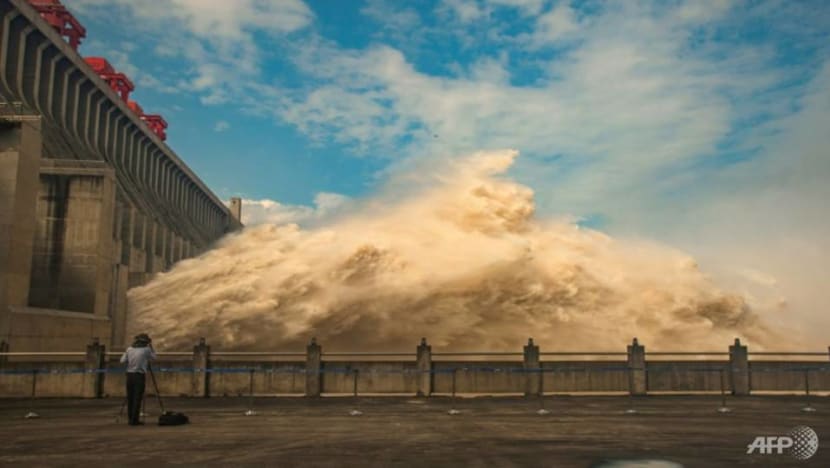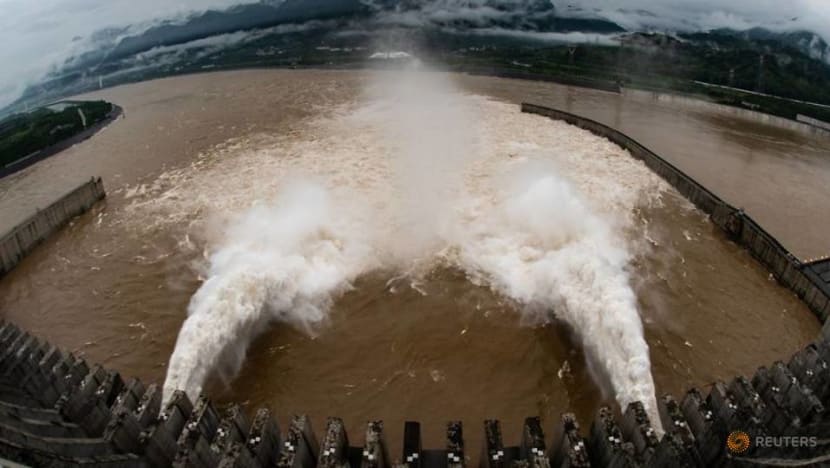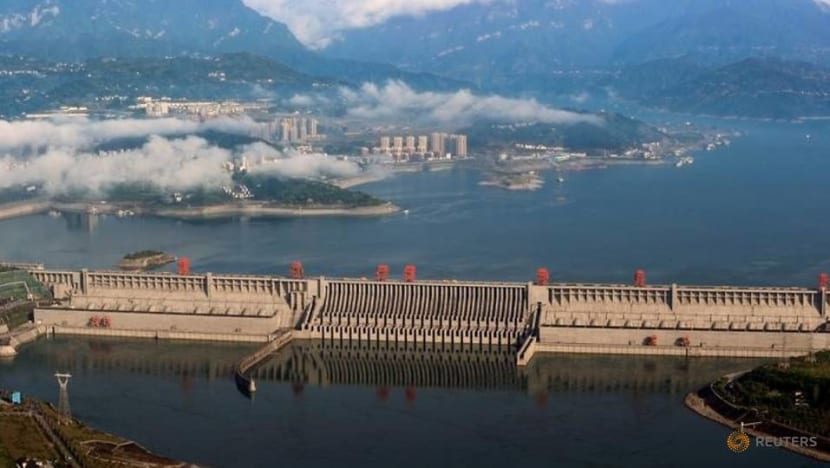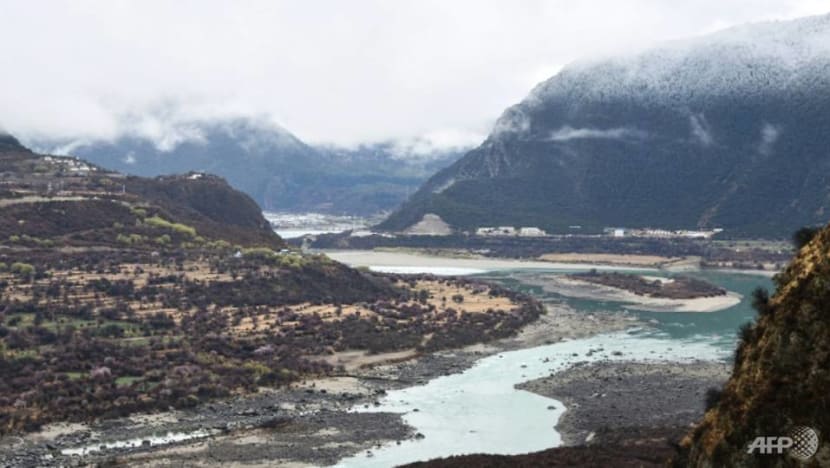Commentary: China has an insatiable appetite for super dams

The Three Gorges Dam, a gigantic hydro-power project on the Yangtze river, in China AFP/STR
NEW DELHI: The Communist Party of China (CCP) will stage a patriotic extravaganza on Jul 1 to celebrate the 100th anniversary of its founding.
Among the achievements it will celebrate is the Baihetan Dam, located on the Jinsha River, on the southeastern edge of the Tibetan Plateau. The dam will start operations on the same day.
The CCP loves a superlative. It is the world’s largest manufacturer and exporter, with the world’s largest foreign reserves. It boasts the world’s highest railway and the highest and longest bridges.
It is also the world’s most dammed country, with more large dams than the rest of the world combined, and prides itself on having the world’s biggest water-transfer canal system.
(Can China make good on its climate targets? Chen Gang gives his take on CNA's The Climate Conversations:)
HYDROENGINEERING PROWESS
The dams themselves are often superlative. The Three Gorges Dam is the world’s largest power station, in terms of installed capacity, and the Baihetan Dam is billed as the world’s biggest arch dam, as well as the world’s first project to use a giant one-gigawatt (GW) hydro-turbine generator.
With 16 such generators, Baihetan ranks as the world’s second-largest hydroelectric dam (behind the Three Gorges Dam, at 22.5 GW).
All of this makes great fodder for CCP -fueled nationalism – essential to the party’s legitimacy.
China often flaunts its hydroengineering prowess, including its execution of the most ambitious inter-river water transfers ever conceived, to highlight its military and economic might.
RIPARIAN ADVANTAGE
But China’s dams are not merely symbols of the country’s greatness. Nor is their purpose simply to ensure China’s water security, as the CCP claims. They are also intended as a source of leverage that China can use to exert control over downstream countries.
The CCP’s 1951 annexation of the water-rich Tibetan Plateau – the starting point of Asia’s ten major river systems – gave China tremendous power over Asia’s water map.

In the ensuing decades, the country has made the most of this riparian advantage. For example, by building 11 giant dams on the Mekong, just before the river crosses into Southeast Asia, China has secured the ability to turn off the region’s water tap.
But the CCP is failing to consider the high costs of its strategy, which extend far beyond political friction with neighbours. The party’s insatiable damming is wreaking environmental havoc on Asia’s major river systems, including mainland China’s dual lifelines: The Yellow and Yangtze rivers.
Giant dams damage ecosystems, drive freshwater species to extinction, cause deltas to retreat, and often emit more greenhouse gases than fossil-fuel power plants. More than 350 lakes in China have disappeared in recent decades, and, with few free-flowing rivers left, river fragmentation and depletion have become endemic.
READ: Commentary: Why China believes it’s go big on carbon emission cuts or go home
READ: Commentary: Cooperation between US, China at global climate summit could yield significant benefits
HUGE SOCIAL COSTS
The social costs are no less severe. For starters, given shoddy construction in the first three decades of communist rule, about 3,200 dams collapsed by 1981, with the 1975 Banqiao Dam failure alone killing up to 230,000 people.
Of course, China has raised its dam-building prowess dramatically since then, and Baihetan was completed in just four years. But as its early dams age, and weather becomes increasingly extreme, catastrophic failures remain a serious risk.
Moreover, dam projects have displaced an enormous number of Chinese. In 2007, just as China’s mega-dam-building drive was gaining momentum, then-Prime Minister Wen Jiabao revealed that, since the CCP’s rise to power, China had relocated 22.9 million people to make way for water projects – a figure larger than more than 100 countries’ entire populations. The Three Gorges Dam alone displaced more than 1.4 million people.
READ: Commentary: Why is former Chinese premier Wen Jiabao’s eulogy about his mother being censored?

This doesn’t seem to bother the CCP much. Baihetan’s inundation of vast stretches of a sparsely populated highland has forced local residents, mostly from the relatively poor Yi ethnicity, to farm more marginal tracts at higher elevations.
As China shifts its focus from the dam-saturated rivers in its heartland to rivers in the ethnic-minority homelands, China’s economically and culturally marginalised communities will suffer the most.
SIGHTS ON ANOTHER SUPER DAM
And there is little doubt that this will happen. The CCP has now set its sights on building the world’s first super-dam, on the Yarlung Zangbo river – better known as the Brahmaputra – near Tibet’s heavily militarised border with India.
The Brahmaputra curves around the Himalayas in a U-turn and forms the planet’s longest and deepest canyon, as it plunges from an altitude of 2,800m toward the Indian floodplains.
Damming it means building at an elevation of more than 1,500m – the highest at which a mega-dam has ever been built. And because the gorge holds the world’s largest untapped concentration of river energy, the super-dam is supposed to have a hydropower generating capacity of 60 GW, nearly three times that of the Three Gorges Dam.

READ: Commentary: Did the world just get a second Belt and Road Initiative?
The fact that the gorge is one of the world’s most biodiverse regions seems to be of little concern to the CCP, which is far more interested in being able to use water as a weapon against India, its Asian rival.
China has already set the stage for construction, recently completing a highway through the canyon and announcing the start of high-speed train service to a military town near the gorge. This will enable the transport of heavy equipment, materials, and workers to the remote region, which was long thought inaccessible because of its treacherous terrain.
The CCP views its centenary as cause for celebration. But the rest of the world should see the party for what it is and prepare for what the CCP’s second century may bring.
Brahma Chellaney, Professor of Strategic Studies at the New Delhi-based Center for Policy Research and Fellow at the Robert Bosch Academy in Berlin, is the author of nine books, including Asian Juggernaut, Water: Asia’s New Battleground, and Water, Peace, and War: Confronting the Global Water Crisis.










